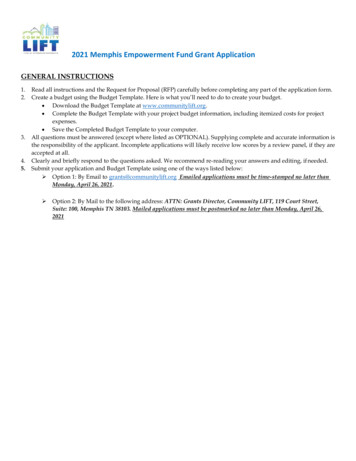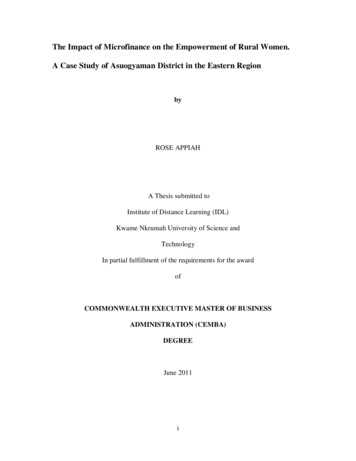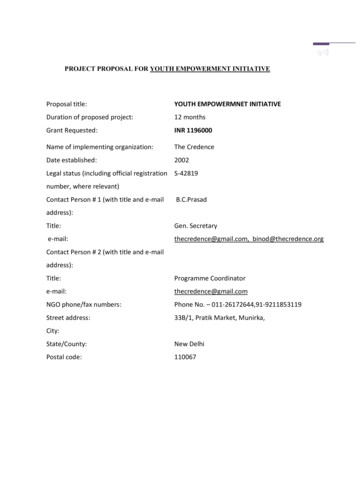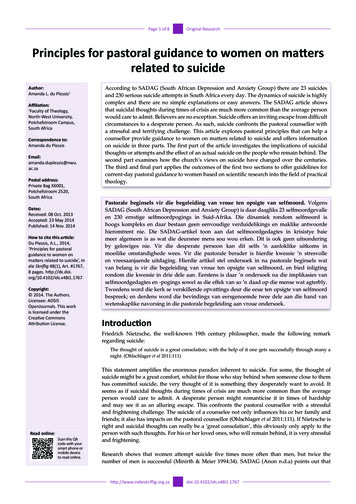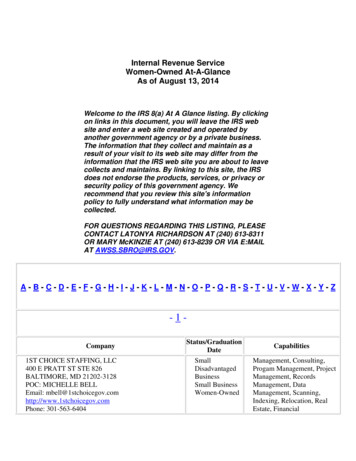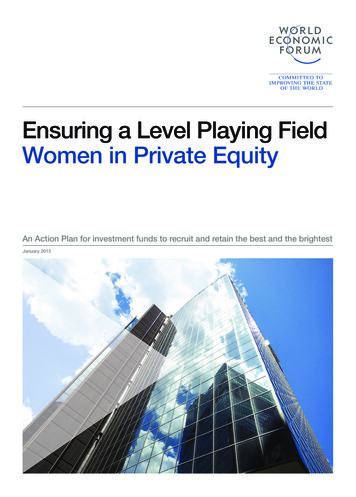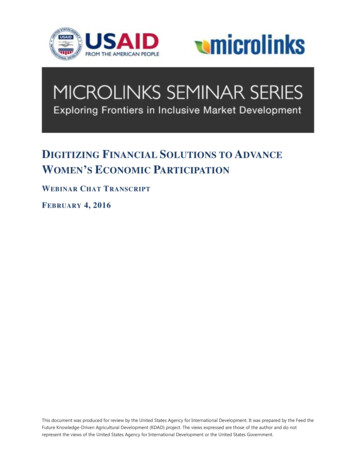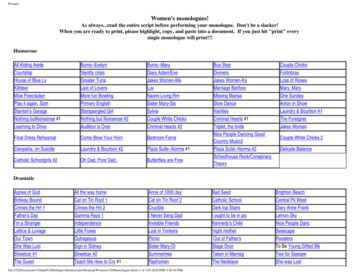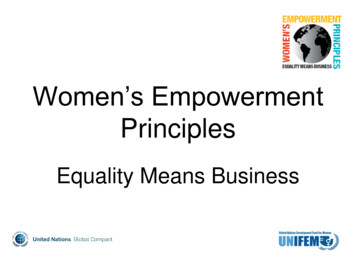
Transcription
Women’s EmpowermentPrinciplesEquality Means Business
Women’s Empowerment Principles in Brief1. Establish high-level corporate leadership for gender equality.2. Treat all women and men fairly at work – respect and supporthuman rights and nondiscrimination.3. Ensure the health, safety and well-being of all women and menworkers.4. Promote education, training and professional development forwomen.5. Implement enterprise development, supply chain and marketingpractices that empower women.6. Promote equality through community initiatives and advocacy.7. Measure and publicly report on progress to achieve genderequality.
Principle 1:Leadership Promotes Gender Equalitya.Affirm high-level support and direct top-level policies forgender equality and human rights.b.Establish company-wide goals and targets for genderequality and include progress as a factor in managers’performance reviews.c.Engage internal and external stakeholders in thedevelopment of company policies, programmes andimplementation plans that advance equality.d.Ensure that all policies are gender-sensitive – identifyingfactors that impact women and men differently – and thatcorporate culture advances equality and inclusion.
Principle 2:Equal Opportunity, Inclusion and Nondiscriminiationa.b.c.d.e.f.Pay equal remuneration, including benefits, for work of equalvalue and strive to pay a living wage to all women and men.Ensure that workplace policies and practices are free fromgender-based discrimination.Implement gender-sensitive recruitment and retentionpractices and proactively recruit and appoint women tomanagerial and executive positions and to the corporateboard of directors.Assure sufficient participation of women – 30% or greater –in decision-making and governance at all levels and acrossall business areas.Offer flexible work options, leave and re-entry opportunitiesto positions of equal pay and status.Support access to child and dependent care by providingservices, resources and information to both women and men.
Principle 3:Health, Safety and Freedom from Violencea.b.c.d.e.f.Taking into account differential impacts on women and men,provide safe working conditions and protection from exposureto hazardous materials and disclose potential risks, including toreproductive health.Establish a zero-tolerance policy towards all forms of violenceat work, including verbal and/or physical abuse, and preventsexual harassment.Strive to offer health insurance or other needed services –including for survivors of domestic violence – and ensure equalaccess for all employees.Respect women and men workers’ rights to time off for medicalcare and counseling for themselves and their dependents.In consultation with employees, identify and address securityissues, including the safety of women traveling to and fromwork and on company-related business.Train security staff and managers to recognize signs ofviolence against women and understand laws and companypolicies on human trafficking, labour and sexual exploitation.
Principle 4:Education and Traininga.Invest in workplace policies and programmes thatopen avenues for advancement of women at all levelsand across all business areas, and encourage womento enter nontraditional job fields.b.Ensure equal access to all company-supportededucation and training programmes, including literacyclasses, vocational and information technologytraining.c.Provide equal opportunities for formal and informalnetworking and mentoring.d.Offer opportunities to promote the business case forwomen’s empowerment and the positive impact ofinclusion for men as well as women.
Principle 5:Enterprise Development, Supply Chainand Marketing Practicesa.b.c.d.e.Expand business relationships with women-ownedenterprises, including small businesses, and womenentrepreneurs.Support gender-sensitive solutions to credit andlending barriers.Ask business partners and peers to respect thecompany’s commitment to advancing equality andinclusion.Respect the dignity of women in all marketing andother company materials.Ensure that company products, services and facilitiesare not used for human trafficking and/or labour orsexual exploitation.
Principle 6:Community Leadership and Engagementa.b.c.d.e.Lead by example – showcase company commitment togender equality and women’s empowerment.Leverage influence, alone or in partnership, to advocatefor gender equality and collaborate with businesspartners, suppliers and community leaders to promoteinclusion.Work with community stakeholders, officials and othersto eliminate discrimination and exploitation and openopportunities for women and girls.Promote and recognize women’s leadership in, andcontributions to, their communities and ensure sufficientrepresentation of women in any community consultation.Use philanthropy and grants programmes to supportcompany commitment to inclusion, equality and humanrights.
Principle 7:Transparency, Measuring and Reportinga.Make public the company policies andimplementation plan for promoting gender equality.b.Establish benchmarks that quantify inclusion ofwomen at all levels.c.Measure and report on progress, both internallyand externally, using data disaggregated bygender.d.Incorporate gender markers into ongoing reportingobligations.
WEPs as a Tool Focusing on how to bring the private sector can play into promoting gender equality and women'sempowerment Take them into account in developing and revising publicpolicies on gender equality and women's empowermentand corporate responsibility Use them when engaging in dialogue with the privatesector about their role Consider corporate commitment the WEPs when makingdecisions about which businesses to partner with,procure from, or other such economic decisions.
Materials and ResourcesFor more information, please visit:http://www.unglobalcompact.org/Issues/human rights/equality means womens empowerment principles/
THANK YOU
Women’s Empowerment Principles in Brief 1. Establish high-level corporate leadership for gender equality. 2. Tr


